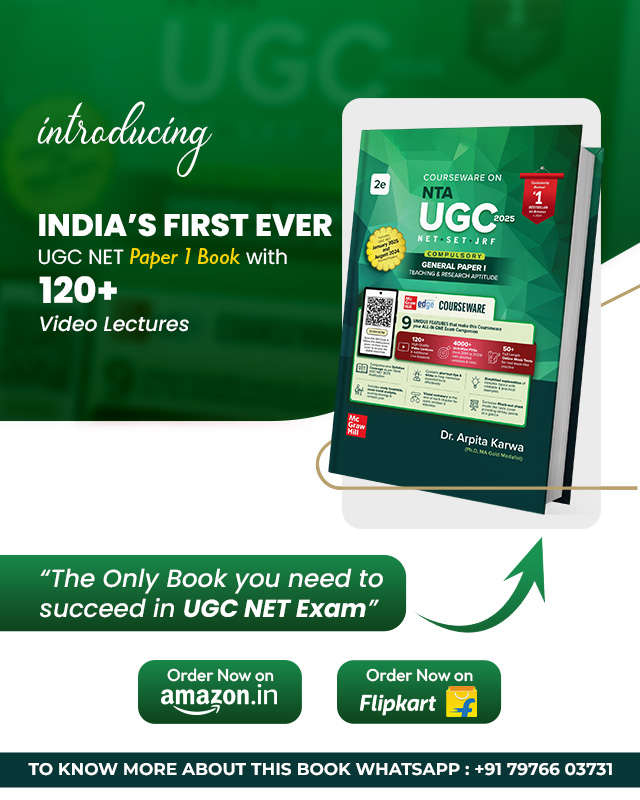CUCET M.A. ENGLISH, ENTRANCE EXAM 2021
June 19, 2023 2023-12-05 16:50CUCET M.A. ENGLISH, ENTRANCE EXAM 2021
CUCET M.A. English, Entrance Exam 2021
CUCET
M.A. ENGLISH, 2021
PART-A
Q.1) Select the correct word that can best complete the given sentence:
A well-balanced diet can be a/an……..for stress.
[1] spirit
[2] buffer
[3] antidote
[4] medicine
Answer: antidote
Q.2) From the choices given below, select the pair which exhibits the same relationship as the one in capitalized pair of words:
HERBS: MEDICINE
[1] books: knowledge
[2] sound: radio
[3] time: watch
[4] juice: orange
Answer: books: knowledge
Q.3) Select the most suitable synonym:
ADEPT
[1] devious
[2] wily
[3] clumsy
[4] dexterous
Answer: dexterous
Q.4) Identify the part of the body with which the disease is associated:
Hepatitis
[1] gall bladder
[2] diaphragm
[3] stomach
[4] liver
Answer: liver-Hepatitis is an inflammation of the liver. The condition can be self-limiting or can progress to fibrosis (scarring), cirrhosis or liver cancer. Hepatitis viruses are the most common cause of hepatitis in the world but other infections, toxic substances (e.g. alcohol, certain drugs), and autoimmune diseases can also cause hepatitis.
There are 5 main hepatitis viruses, referred to as types A, B, C, D and E. These 5 types are of greatest concern because of the burden of illness and death they cause and the potential for outbreaks and epidemic spread. In particular, types B and C lead to chronic disease in hundreds of millions of people and, together, are the most common cause of liver cirrhosis and cancer.
Hepatitis A and E are typically caused by ingestion of contaminated food or water. Hepatitis B, C and D usually occur as a result of parenteral contact with infected body fluids. Common modes of transmission for these viruses include receipt of contaminated blood or blood products, invasive medical procedures using contaminated equipment and for hepatitis B transmission from mother to baby at birth, from family member to child, and also by sexual contact. Acute infection may occur with limited or no symptoms, or may include symptoms such as jaundice (yellowing of the skin and eyes), dark urine, extreme fatigue, nausea, vomiting and abdominal pain.
Q.5) Identify the meaning of the expression below from the options given:
ex officio
[1] unofficial
[2] as a result of one’s
[3] a retired official
[4] make public
Answer: as a result of one’s
Q.6) Identify the meaning of the underlined word:
Confidence in government hospitals has eroded considerably in the past decade.
[1] gradually destroyed
[2] been reimposed
[3] corroded
[4] withered
Answer: gradually destroyed
Q.7) Identify the meaning of the phrase below from the options given:
A person who helps others specially those who are poor or in trouble
[1] philhellene
[2] philadelphus
[3] philanderer
[4] philanthropist
Answer:philanthropist
Q.8) Select the most suitable antonym:
ERRATIC
[1] loose
[2] faulty
[3] regular
[4] brave
Answer: regular
Q.9) Identify the meaning of the idiom from the options given:
A bird’s-eye view
[1] without care
[2] within the walls
[3] an overall view
[4] out of place
Answer: an overall view
Q.10) Select the correct word from the answer:
Farmers know that changing winds ………… rain or drought.
[1] bring
[2] create
[3] form
[4] present
Answer: bring
Q.11) The H.C.F. (Highest Common Factor) of 3556 and 3444 is:
[1] 23
[2] 25
[3] 26
[4] 28
Answer: 28
3556 = 4 x 7 x 127 and
344 = 4 x 7 x 123
H.C.F. of 3556 and 3444 = 4 x 7 = 28
Q. 12) If a + b = 5 and 3a + 2b = 20, then (3a + b) will be:
[1] 10
[2] 15
[3] 20
[4] 25
Answer: 25
Given, a + b = 5
and 3a + 2b = 20
=> 3a + 2(5 – a) = 20
=> 3a + 10 – 2a = 20
=> a + 10 = 20
=> a = 10
b = 5 – a = 5 – 10 = – 5
Hence, 3a + b = 3 x 10 – 5
= 30-5 = 25.
Q.13) If the sum of a number and its square is 182, what is the number?
[1] 15
[2] 26
[3] 28
[4] None of these
Answer: None of these
Let the number is x
Then, x+x² = 182
x²+x-182= 0
x²+14x-13x-182= 0
x(x+14) – 13(x+14) = 0
(x-13) (x+14) = 0
x-13= 0 or x+14=0
x= +13 or x= -14
Hence, number is 13, -14.
Q.14) 88% of 370 + 24% of 210-? = 118
[1] 256
[2] 258
[3] 268
[4] 358
Answer: 258
Q.15) Choose the correct alternative based on relationship:
Tractor:Trailer::Horse: ?
[1] Stable
[2] Cart
[3] Saddle
[4] Engine
Answer: Cart
Q.16) Choose the word which is least like the other words in the group:
[1] Geometry
[2] Algebra
[3] Trigonometry
[4] Mathematics
Answer: Mathematics
Q.17) Choose the number which is different from others in the group.
[1] 8314
[2] 2709
[3] 1315
[4] 2518
Answer: 8314
Q.18) If PALE is coded as 2134, EARTH is coded as 41590, how is PEARL coded in that code?
[1] 29530
[2] 24153
[3] 25413
[4] 25430
Answer: 24153
Q.19) Rahul told Anand, ‘Yesterday I defeated the only brother of the daughter of my grandmother.’ Whom did Rahul defeat?
[1] Son
[2] Father
[3] Brother
[4] Father-in-law
Answer: Father
Q.20) Arrange the given words in alphabetical order and choose the one that comes first.
[1] Science
[2] Scrutiny
[3] Scripture
[4] Scramble
Answer: Science – According to alphabetical order Science → Scramble → Scripture → Scrutiny.
Q.21) If Atul finds that he is twelfth from the right in a line of boys and fourth from the left, how many boys should be added to the line such that there are 28 boys in the line?
[1] 12
[2] 13
[3] 14
[4] 20
Answer: 13 – The number of students in a line of boys
= 12 +41-1 = 16-1 = 15
Hence, the number of boys should be added to the line
= 28-15= 13.
Q.22) The India Energy Outlook 2021 is a new special report from the:
[1] NITI Aayog
[2] Ministry of Power
[3] International Energy Agency
[4] Ministry of New and Renewable Energy
Answer:International Energy Agency -The India Energy Outlook 2021 is a new special report from the International Energy Agency’s World Energy Outlook series. The report explores the opportunities and challenges ahead for India as it seeks to ensure reliable, affordable and sustainable energy to a growing population. The report examines pathways out of the crisis that emerged from the Covid-19 pandemic, as well as longer-term trends, exploring how India’s energy sector might evolve to 2040 under a range of scenarios.
The report is presented as a series of ‘deep dives’ exploring cross-cutting issues, including: The effects of economic growth, urbanisation and industrialisation on India’s fuel and sector-level demand trends. The evolution of mobility, including electrification, in the context of growing urbanisation. The prospects for expanding energy access, especially in rural areas. Flexibility requirements in the power sector under ambitious renewable capacity targets and a significant rise in electricity demand-especially from air conditioners. Challenges and opportunities for clean energy finance, including investments in solar energy and batteries. The supply and infrastructure required for an expanded role for natural gas, along with a sector-level assessment of its potential. Impacts of India’s energy policy choices on energy access, air pollution and carbon emissions. India’s growing importance in global energy issues, and the implications of its development trajectory on international energy supply, trade and investment.
Q.23) Who among the following wrote the famous book titled ‘We the people’?
[1] T.N. Seshan
[2] Kiran Bedi
[3]NanabhoyPalkhivala
[4] Khushwant Singh
Answer: NanabhoyPalkhivala- ‘We the people’ is a book by Nani A. Palkhivala. Palkhivala in his book discusses many subjects- education and democracy; economic growth and social justice etc.
Q.24) Which of the following committees is related to ‘Personal Data Protection’?
[1] B. N. Srikrishna Committee
[2] C. Rangarajan Committee
[3] Bimal Jalan Committee
[4]Bhurelal Committee
Answer: B. N. Srikrishna Committee – In July 2017, the Ministry of Electronics and Information Technology set up a committee to study issues related to data protection. The committee was chaired by retired Supreme Court judge Justice B.N. Srikrishna.
Q.25) Galathea National Park is located in:
[1] Andaman and Nicobar
[2] Lakshadweep
[3] Coromandel Coast
[4] Konkan Coast
Answer: Andaman and Nicobar – Galathea National Park is a National Park located in the Union Territory of Andaman and Nicobar Islands, India. It is located on the island of Great Nicobar in the Nicobar Islands. The total area of this park is some 110 square kilometres, and it was gazetted as a National Park of India in 1992.
Galathea forms part of what has been designated as the Great Nicobar Biosphere Reserve, which also includes the larger Campbell Bay National Park, separated from Galathea by a 12-km forest buffer zone.
The Galathea National Park comprises the core area of the southern part of the Biosphere Reserve in Great Nicobar Island and consists of lowland forests which have the greatest abundance of endemic avifauon.
It is the prime nesting habitat of the Nicobar Megapode and possibly the area of other endemic species too.
Flora: Tropical and subtropical moist broadleaf forests.
Fauna: Notable animal species giant robber crab, Megapode and Nicobar pigeon.
PART-B
Q.26) …………………is the smallest element in a language.
[1] Morpheme
[2] Phoneme
[3] Lexeme
[4] Allomorph
Answer: Phoneme
Q.27) “Sprung Rhythm” is attributed to which of the following poems?
[1] “Kubla Khan” by S.T. Coleridge
[2] “The Waste Land” by T.S. Eliot
[3] “Easter 1916” by W.B. Yeats
[4] “Windhover” by G.M. Hopkins
Answer: “Windhover” by G.M. Hopkins
Q.28) Which of the following concepts is Bertolt Brecht related with?
[1] Alienation Effect
[2]Post dramatic Theatre
[3] Naturalistic Drama
[4] Theatre of the Absurd
Answer: Alienation Effect
Q.29) Who is known as the “Nightingale of India”?
[1] Lata Mangeshkar
[2] Sarojini Naidu
[3] K.S. Chitra
[4] Parvathy Baul
Answer: Sarojini Naidu was the first Indian woman to be president of the Indian National Congress and to be appointed an Indian state governor. She was called “the Nightingale of India.” Her first volume of poetry, The Golden Threshold (1905), was followed by The Bird of Time (1912), and in 1914 she was elected a fellow of the Royal Society of Literature. Her collected poems, all of which she wrote in English, have been published under the titles The Sceptred Flute (1928) and The Feather of the Dawn (1961).
Q.30) Name the floating island in Gulliver’s Travels by Jonathan Swift:
[1] Yahoos
[2]Glumdalclitch
[3] Laputa
[4] Houyhnhnms
Answer: Laputa
Q.31) Which of these following literary genres emerged first?
[1] Poetry
[2] Drama
[3] Novel
[4] Memoirs
Answer: Poetry
Q.32) Who among the following is a Metaphysical Poet?
[1] John Dryden
[2] W.H. Auden
[3] Andrew Marvell
[4] Thomas Gray
Answer: Andrew Marvell
Q.33) In which year was Macaulay’s “Minute” released?
[1] 1897
[2] 1660
[3] 1895
[4]1835
Answer: 1835 – On 2 February 1835, British historian and politician Thomas Babington Macaulay presented his ‘Minute on Indian Education’ that sought to establish the need to impart English education to Indian ‘natives’.
Macaulay’s proposals were officially sanctioned in March, 1835. In 1837, English was made the court language. In 1844, high government posts were open to Indians.
Macaulay was a proud Englishman convinced of his own nation’s greatness and achievements, which he considered the best whether it was in the sciences or the arts. Nothing wrong with that, except that he was perhaps too prejudiced to see things from a different perspective. His famous minute will reveal his scant regard for anything Indian.
Macaulay was a proud Englishman convinced of his own nation’s greatness and achievements, which he considered the best whether it was in the sciences or the arts. Nothing wrong with that, except that he was perhaps too prejudiced to see things from a different perspective. His famous minute will reveal his scant regard for anything Indian.
In his minute on education, he justified the use of English as the medium of instruction, and also the teaching of western education to Indians.
He lampooned Indian knowledge and languages and thought them completely worthless. For instance, he said of Indian literature:
“…a single shelf of a good European library was worth the whole native literature of India and Arabia.”
Q.34)Which is the bimonthly journal published by Sahitya Akademi?
[1] Literary Criterion
[2] Indian Literature
[3]Littcrit
[4] Literature Today
Answer: Indian Literature – Sahitya Akademi publishes three literary journals of international repute, one each in English, Hindi & Sanskrit.
English literary journal Indian Literature is published once in two months as is Hindi journal Samkaleen Bhartiya Sahitya. The Sanskrit literary journal, Samskrita Pratibha is published every quarter.
All the three journals publish translations from 23 other languages apart from the creative writing in the language of the journal.
Indian Literature is being published uninterrupted from 1957, Samskrita Pratibha from 1959 &Samkaleen Bhartiya Sahitya from 1980.
Q.35) Who is the current Poet Laureate of England?
[1] Ted Hughes
[2] Simon Armitage
[3] Carol Ann Duffy
[4] Andrew Motion
Answer: Simon Armitage
Q.36) With whom is the theory of the Sublime associated?
[1] Longinus
[2] Montaigne
[3] Rosseau
[4] Aristotle
Answer: Longinus
Q.37) Train to Pakistan, a novel by Khushwant Singh, was first published in the year……….
[1] 1948
[2] 1956
[3] 1950
[4] 1955
Answer: 1956
Q.38) Erik Arthur Blair used the pseudonym………. .
[1] Lewis Carroll
[2] Saki
[3] Mark Twain
[4] George Orwell
Answer: George Orwell
Q.39) The Marathi film Court (2014) was directed by………. .
[1] Nagraj Anjule
[2] Gajendra Ahire
[3] Paresh Okashi
[4] Chaitanya Tamhane
Answer: Chaitanya Tamhane
Q.40) Who is known as the father of Indian cinema?
[1] H.S. Bhatavdekar
[2] D.G. Phalke
[3] V. Shantaram
[4] J.C. Daniel
Answer: D.G. Phalke – Dadasaheb Phalke was an Indian producer, director, and screenwriter. He is known as the Father of Indian Cinema.
The Dadasaheb Phalke Award, awarded to people who worked for a long time to the Indian cinema, was created in his honour by the Government of India in 1969.
Q.41) Match List-I with List-II.
List-I
(a) Tamasha
(b) Bhavai
(c) Theyyam
(d) Jatra
List-II
(i) Kerala
(ii) West Bengal
(iii) Maharashtra
(iv) Rajasthan
Choose the correct answer from the options given below:
[1] a-iii, b-iv, c-i, d-ii
[2] a-iv, b-iii, c-ii, d-i
[3] a-ii, b-i, c-iii, d-iv
[4] a-i, b-ii, c-iv, d-iii
Answer: a-iii, b-iv, c-i, d-ii
Q.42) How many languages are there in the VIII Schedule of the Constitution of India?
[1] 20
[2] 23
[3] 22
[4] 24
Answer: 22
There are 22 official languages in India and they are covered under the 8th schedule of the Indian Constitution.
Who is the Speaker?
[1] Prospero
[2] Caliban
[3] Ariel
[4] Sycorax
Answer: Caliban
Q.44) Who is the narrator of The Heart of Darkness by Joseph Conrad?
[1] Kurtz
[2]Fresleven
[3] Charles Marlow
[4] Aunt
Answer: Charles Marlow
Q.45) Which one of the following words is suitable for Arnold’s description:
“Worldly-wise men, captains of industry busy in trade and commerce”?
[1] The Capitalists
[2] The Aristocratics
[3] The Populace
:[4] The Philistines
Answer: The Philistines
Q.46) Which of the following “rasa” is not suggested inNatyasastra?
[1] Karuna
[2] Santa
[3]Raudra
[4] Bhayanaka
Answer: Santa
Q.47) In Indian Aesthetics “Vakrokti” is a major theorization.
Who proposed it?
[1]Abhinavagupta
[2]Aswaghosha
[3] Bharata
[4] Kuntaka
Answer: Kuntaka
Q.48) Who is the author of Understanding Fiction?
[1] Dover Wilson
[2] Cleanth Brooks
[3] Rene Wellek
[4] R.S. Crane
Answer: Cleanth Brooks
Q.49) In linguistics “knew” and “new” are examples of…….:
[1] Homophone
[2] Homonym
[3] Allophone
[4] Antonym
Answer: Homophone
Q.50) What is onomatopoeia?
[1] A word which lexically imitates the sound it describes
[2] A word which morphologically imitates the soundit describes
[3] A word which semantically imitates the sound it describes
[4] A word which phonetically imitates the sound itdescribes
Answer: A word which phonetically imitates the sound it describes
Q.51) In which year was Rabindranath Tagore awarded the Nobel Prize for Literature?
[1] 1948
[2] 1913
[3] 1931
[4] 1930
Answer: 1913
Q.52) Who is the director of the 1982 film Gandhi?
[1] Danny Boyle
[2] Steven Spielberg
[3] Richard Attenborough
[4] Peter Brook
Answer: Richard Attenborough
Q.53) Which of the following is not related to the classical parameters of drama?
[1] Unity of Time
[2] Unity of Thought
[3] Unity of Action
[4] Unity of Place
Answer: Unity of Thought
Q.54) What is the full form of CLAI?
[1] Comparative Language Association of India
[2] Comparative Linguistic Association of India
[3] Comparative Literature Association of India
[4] Comparative Literary Association of India
Answer: Comparative Literature Association of India
Q.55) A poem composed without any particular metrical pattern is known as a…….. .
[1] Blank Verse
[2] Elegy
[3] Ode
[4] Free Verse
Answer: Free Verse
Q.56) Who among the following is chiefly associated with the poetic form ‘dramatic monologue’?
[1] Robert Browning
[2] Seamus Heaney
[3] W.H. Auden
[4] G.M. Hopkins
Answer: Robert Browning
Q.57) The idea of “dissociation of sensibility” is attributed to……. .
[1] S.T. Coleridge
[2] T.S. Eliot
[3] E.M. Foster
[4] F.L. Lucas
Answer: T.S. Eliot
Q.58) In which year was the Bible translated into English for the first time?
[1] 1382
[2] 1352
[3] 1358
[4] 1385
Answer: 1382
Q.59) The Bhagavat Gita is included in which part of the Mahabharata?
[1]Virata Parva
[2] Sabha Parva
[3]Bhishma Parva
[4]Mahaprasthanika Parva
Q.60) Expand ISA of Louis Althusser:
[1] Ideological State Appropriation
[2] Imaginary System Appropriation
[3] Ideological State Apparatuses
[4] Imaginary System Apparatuses
Answer: Ideological State Apparatuses
Q.61) “I speak three languages, write in two, dream in one.” Who said this?
[1]Kamala Das.
[2] R.K. Narayan
[3] Ruskin Bond
[4] Khushwant Singh
Answer: Kamala Das
Q.62) The word RADAR is an example of………. .
[1] Synonym
[2] Acronym
[3] Homonym
[4] Antonym
Answer: Acronym
Q.63) The regional form of language is called a……… .
[1] Idiolect
[2] Register
[3] Accent
[4] Dialect
Answer: Dialect
Q.64) Who is the author of the play Hayavadana?
[1] Mohan Rakesh
[2] Mahesh Dattani
[3]Girish Karnad
[4] Vijay Tendulkar
Answer: Girish Karnad
Q.65) What do you call a novel written in the form of a series of letters or documents?
[1] Allegory
[2] Documentary
[3] Didactic
[4] Epistolary
Answer: Epistolary
Q.66) The scientific study of linguistic meaning is called……….. .
[1] Pragmatics
[2] Semantics
[3] Syntax
[4] Etymology
Answer: Semantics
Q.67) “How weary, state, flat and unprofitable Seem to me all the uses of this world.”-Hamlet This is an example of………… .
[1] Soliloquy
[2] Aside
[3] Monologue
[4] Dialogue
Answer: Soliloquy
Q.68) What is the rhyme scheme of a Petrarchan sonnet?
[1] ABAB CDEF CDEF GG
[2] ABAB CDCD EFEF GG
[3] ABAB ABBA CCDDEE
[4] ABBA ABBA CDECDE
Answer: ABBA ABBA CDECDE
Q.69) Towards an Aesthetics of Dalit Literature is written by………… .
[1]Jyotiba Phule
[2] Sharankumar Limbale
[3] Arjun Dangle
[4] Aravind Malagatti
Answer: Sharankumar Limbale
Q.70) In which year was Mulk Raj Anand’s novel Coolie published?
[1] 1956
[2] 1946
[3] 1936
[4] 1926
Answer: 1936
Q.71) Love is like a war. Which figure of speech is used in this line?
[1] Alliteration
[2] Hyperbole
[3] Simile
[4] Metaphor
Answer: Simile
Q.72) “The Essay of Dramatic Poesy” is written by:
[1] Ben Jonson
[2] John Dryden
[3] T.S. Eliot
[4] Alexander Pope
Answer: John Dryden
Q.73) Which of the following is not a type of Ode?
[1] Regular Ode
[2] Irregular Ode
[3] Pindaric Ode
[4] Horatian Ode
Answer: Regular Ode
Q.74) “TygerTyger, burning bright.
In the forests of the night;
What immortal hand or eye.
Could frame thy fearful symmetry?”
– Who is the author?
[1] Jeoffrey Chaucer
[2] Edmund Spencer
[3]William Blake
[4] S.T. Coleridge
Answer: William Blake
Q.75) Sashi Tharoor’s book An Era of Darkness: The British Empire in India belongs the literary genre…………
[1] Fiction
[2] Non-Fiction
[3] Satire
[4] Epic
Answer: Non-Fiction
Q.76) The Seven Deadly Sins appear in the play:
[1] Much Ado about Nothing
[2] Dr. Faustus
[3] The Apple Cart
[4] The Country Wife
Answer: Dr. Faustus
Q.77) Find out the exact title of Mahatma Gandhi’s autobiography.
[1] My Experiments with Truth
[2] My Experiment with Truth.
[3] The Story of My Experiment with Truth
[4] The Story of My Experiments with Truth
Answer: The Story of My Experiments with Truth
Q.78) Who is known as the father of English essay?
[1] Joseph Addison
[2] Francis Bacon
[3] Richard Steele
[4] Oliver Goldsmith
Answer: Francis Bacon
Q.79) Match List-I with List-II.
List-I
(a) Feminism
(b) Marxism
(c) Postcolonialism
(d) Psychoanalysis
List-II
(i) Chinua Achebe
(ii) Jacques Lacan
(iii) Fredric Jameson
(iv) Bell hooks
Choose the correct answer from the options given below:
[1] a-iv, b-iii, c-i, d-ii
[2] a-iv, b-i, c-iii, d-ii
[3] a-i, b-ii, c-iii, d-iv
[4] a-iii, b-i, c-iv, d-ii
Answer: a-iv, b-iii, c-i, d-ii
Q.80) Which one of these poems is not written by John Keats?
[1] “Ode on a Grecian Urn”
[2] “La Belle Dame Sans Merci”
[3] “The Solitary Reaper”
[4] “Ode to a Nightingale”
Answer: “The Solitary Reaper”
Q.81) Arrange the following plays by Shakespearechronologically.
(a) King Lear
(b) Hamlet
(c) Macbeth
(d) Othello
[1] (d), (c), (b), (a)
[2] (c), (a), (d), (b)
[3] (b), (d), (a), (c)
[4] (a), (b), (d), (c)
Answer: (b), (d), (a), (c)
Q.82) The explication of the slogan ‘Art for Art’s Sake’ is attributed to:
[1] Oscar Wilde
[2] Walter Pater
[3] William Morris
[4] D.G. Rossetti
Answer: William Morris
Q.83) Who wrote the novel Robinson Crusoe?
[1] Daniel Defoe
[2] H.G. Wells
[3] Rudyard Kipling
[4] Thomas Hardy
Answer: Daniel Defoe
Q.84) The theoretical concept of ‘hegemony’ is problematized by:
[1] Raymond Williams
[2] Michel Foucault
[3] Louis Althusser
[4] Antonio Gramsci
Answer: Antonio Gramsci
Q.85) Which of the following is not related to Comparative Literature?
[1] American School
[2] British School
[3] French School
[4] German School
Answer: British School
Q.86) Identify the person who suggested the idea of “World literature”.
[1] Goethe
[2] Dostoevsky
[3] Tagore
[4] Dante
Answer: Goethe
Q.87) Which movement propagated that a work of art is self- sufficient and has no use or moral aim outside its own being?
[1] Symbolism
[2] Aestheticism
[3] Postmodernism
[4] Feminism
Answer: Aestheticism
Q.88) The avant-garde phenomenon is generally attributed to:
[1] Romanticism
[2] Modernism
[3] Classicism
[4] Marxism
Answer: Modernism
Q.89) A word which can be read forward and backward in the same way is called:
[1] Quibble
[2] Oxymoron
[3] Pantomime
[4] Palindrome
Answer: Oxymoron
Q.90) The depiction of everyday life of people is almost accurately is followed in…….. fiction.
[1] Surrealist
[2] Realist
[3] Symbolist
[4] Expressionist
Answer: Expressionist
Q.91) The political pamphlet Annihilation of Caste was written by:
[1] Subhash Chandra Bose
[2] Mahatma Gandhi
[3] B.R. Ambedkar
[4] Jawaharlal Nehru
Answer: B.R. Ambedkar
Q.92) The Romantic Period in British Literature is from to:
[1] 1798 to 1837
[2] 1660 to 1798
[3] 1603 to 1625
[4] 1558 to 1603
Answer: 1798 to 1837
Q.93) Which of these European countries witnessed the beginning of Renaissance?
[1] Germany
[2] England
[3] France
[4] Italy
Answer: Italy
Q.94) The first Jnanpith Award in 1965 was won by:
[1]Umashankar Joshi
[2] G. SankaraKurup
[3]Tarasankar Bandyopadhyay
[4]Kuvempu
Answer: G. SankaraKurup
Q.95) Find the odd one out.
[1] P. B. Shelley
[2] John Keats
[3] Alexander Pope
[4] William Wordsworth
Answer: Alexander Pope
Q.96) In which year was the English playwright William Shakespeare born?
[1] 1564
[2] 1568
[3] 1599
[4] 1546
Answer: 1564
Q.97) Find out the book which is not considered as part of the Theban Trilogy by Sophocles.
[1] Oedipus Rex
[2] Oedipus at Colonus
[3] Antigone
[4] Ajax
Answer: Ajax
Q.98) Find the odd one out.
[1]Mrichakatika
[2]Abhijnanashakuntalam
[3]Kumarasambhavam
[4]Meghaduta
Answer: Mrichakatika
Q.99) Which of the following books was primarily responsible for launching Ecocriticism?
[1] Autumn Fires
[2] The Winter’s Tale
[3] Silent Spring
[4] Butterfly Summer
Answer: Silent Spring
Q.100)Who among the following won the Nobel Prize for literature in 2020?[1] Peter Handke
[2] Kazuo Ishiguro
[3] Louise Gluck
[4] Bob Dylan
Answer: Louise Gluck
Address
Bani Park, Jaipur, Rajasthan 302016
Contact
Connect with us
Address
Bani Park, Jaipur, Rajasthan 302016
Contact
Connect with us
© 2023 ARPITA KARWA EDUCATION (OPC) PRIVATE LIMITED. All Rights Reserved
Request FREE Online Couselling
We at ArpitaKarwa.com love to help people overcome their life challenges & emotional issues. Therefore, we have started a FREE online counselling and emotional support platform to help students deal with your life in a better way.
Sometimes life gets tough, relationships go sour, work gets stressful, loneliness creeps in or anxiety and depression take over. No matter what’s troubling you, we are here to help you. We will connect you to our psychologists over phone FREE of Cost so that you can get guidance about how to study effectively and manage all other aspects of your life.
Our team of counsellors will address the issues you are facing and guide you through completely confidential individual sessions.
Fill the fields below to receive a call from one of our counsellors.

Ask the ALMIGHTY for HIS grace before hitting the books !
We humbly request all our students to start their studies every day after listening this prayer. It is a universal prayer for students from all religion and Arpita Ma’am insist on this because she did this prayer daily during her UGC NET Preparation and the helping hand of ALMIGHTY GOD brought her the desired success.
** The word “Thy” in the prayer stands for the Universal Power who we call by different names (God / Allah / Jesus / Rama / Krishna etc). This prayer urges each one of you to feel the formless presence of God, in you, around you, with you and within you.(Source: www.infinithism.com)
Fill The Fields Below To Access Our Demo Material.
Fill The Fields Below To View Previous Year Question Papers.
Need more assistance? Our experts will reach you
Fill the fields below to receive a call from one of our experts

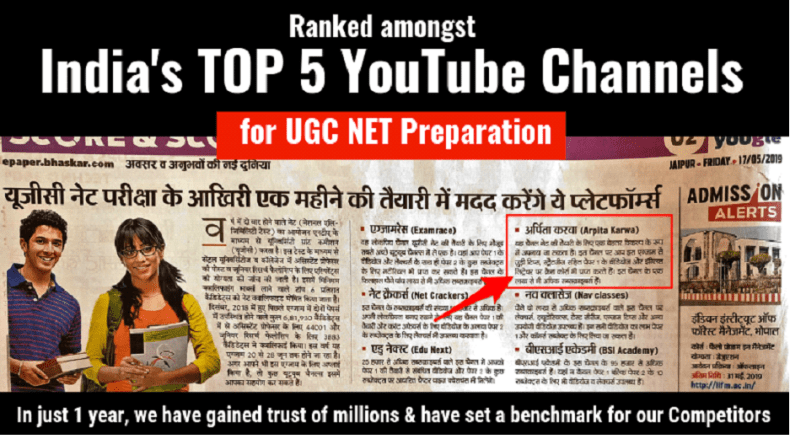
If you want to enrol for any of our Online Courses, but are constrained by financial issues, please fill up this form to avail FREE Course Access (upto 100% Tuition Fee Waiver)
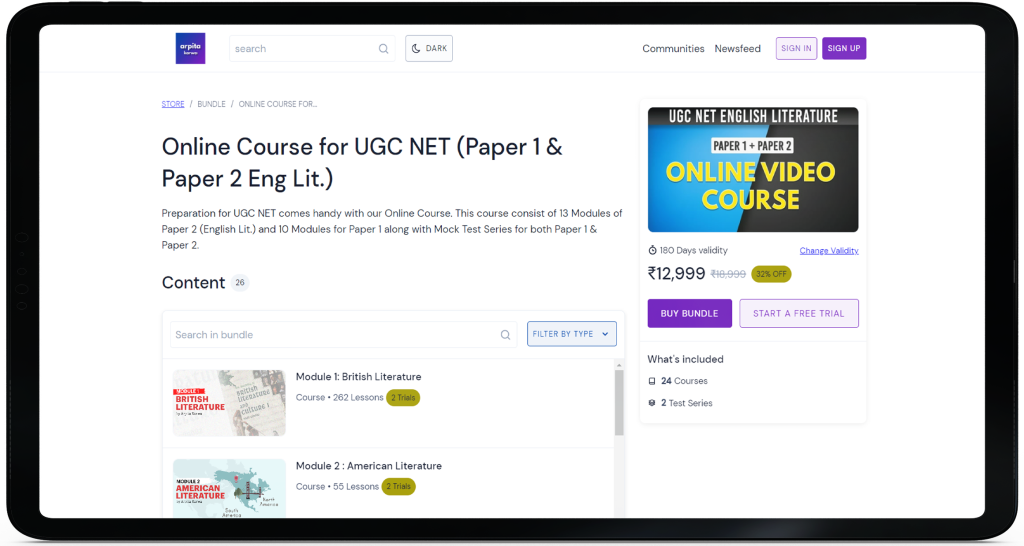
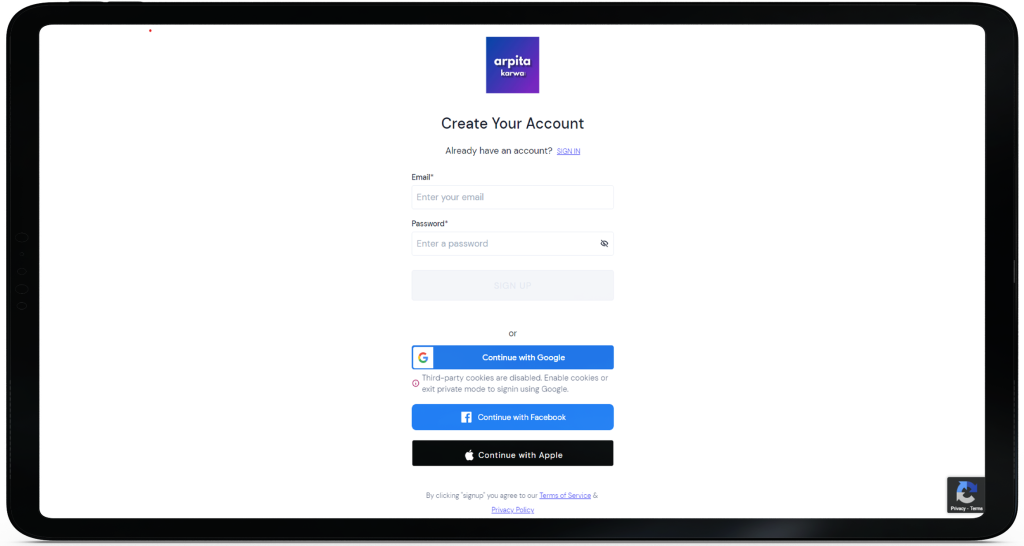
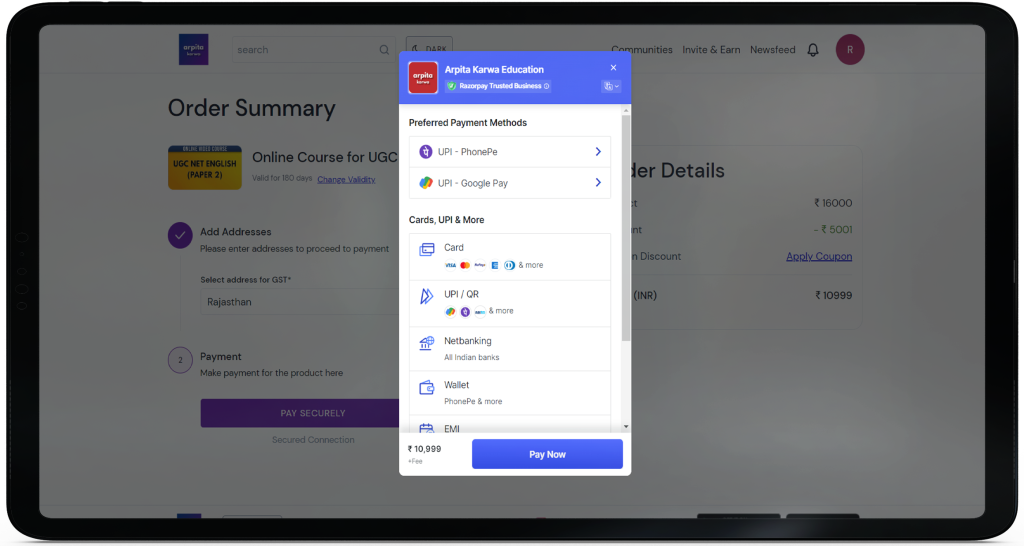
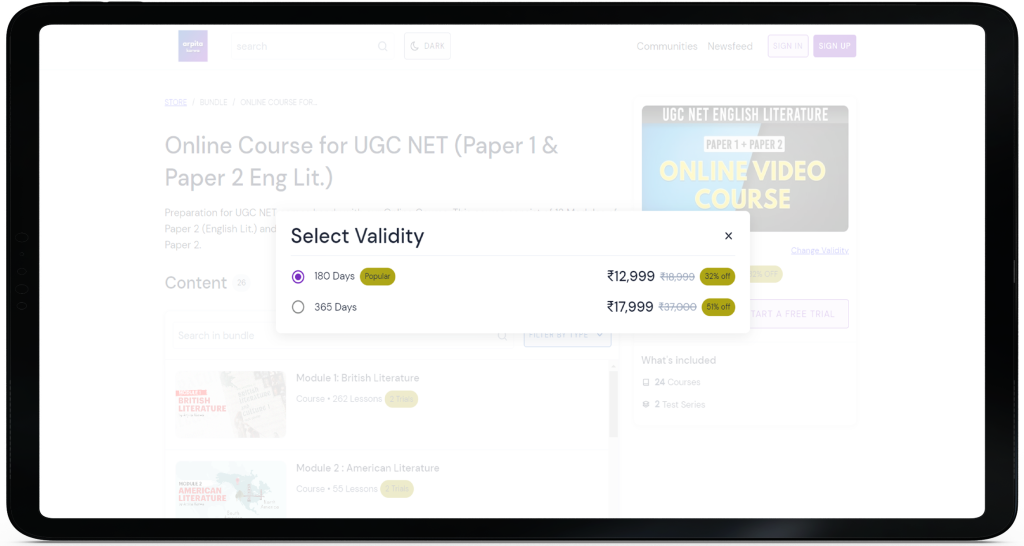

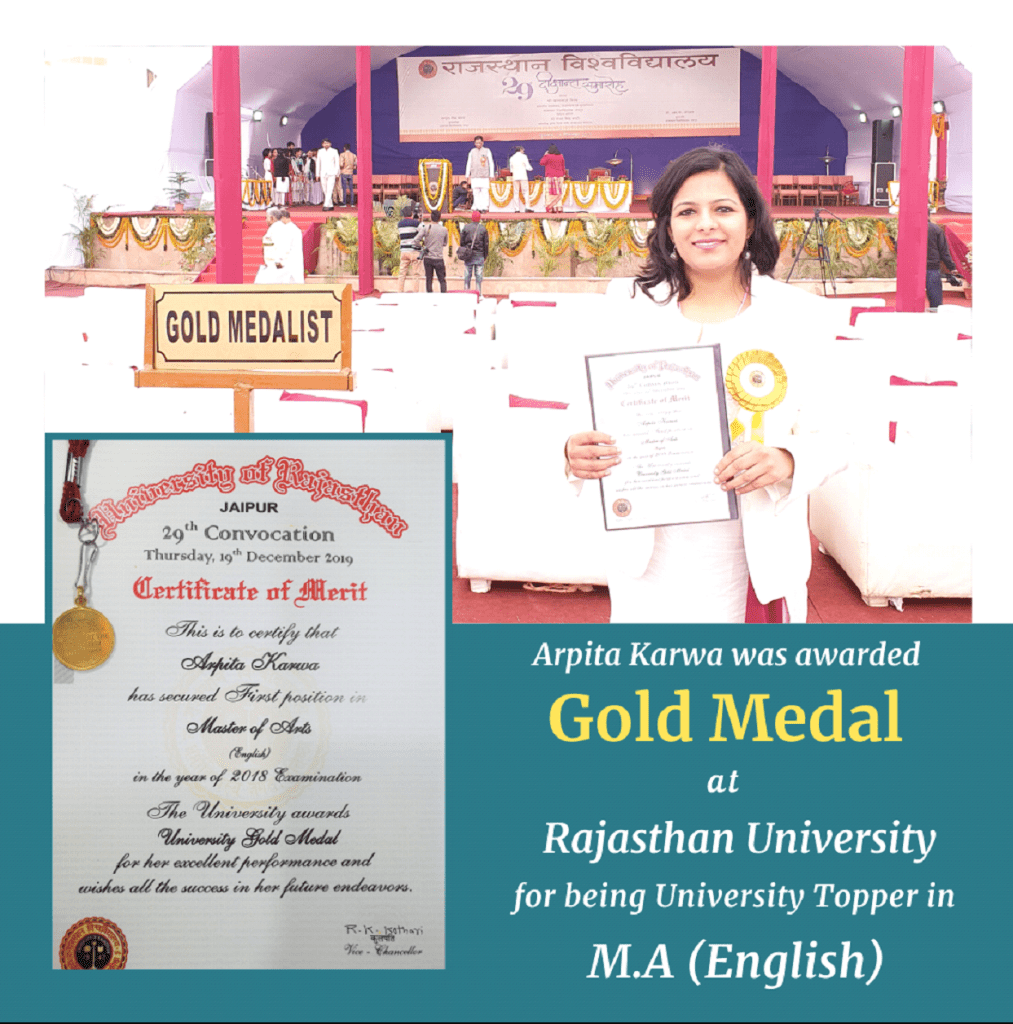
- About us
- August 2024 : Paper 1 (Conduced on 21st August 2024 Evening Shift)
- August 2024 : Paper 1 (Conduced on 21st August 2024 Morning Shift)
- August 2024 : Paper 2 (Conduced on 21st August 2024 Evening Shift)
- August 2024 : Paper 2 (Conduced on 21st August 2024 Morning Shift)
- Blog
- Contact Us
- Course Features
- Demo Material
- FAQ
- FAQ_TEST
- Free Counselling
- June 2024: Paper 2 (Conduced on 18th June 2024)
- Our Results
- Past Year Papers
- March 2023 : Paper 2 (Conduced on 1st March 2023 Morning Shift)
- 14th June 2023 (Paper 1) Shift 1
- 14th June 2023 (Paper 1) Shift 2
- 14th June 2023 (Paper 2 English Literature) Shift 1
- 14th June 2023 (Paper 2 English Literature) Shift 2
- Andhra Pradesh set 1
- Chhattisgarh Set 1
- Chhattisgarh Set 2
- CUCET M.A. ENGLISH, Entrance Exam 2016
- CUCET M.A. ENGLISH, ENTRANCE EXAM 2018
- CUCET M.A. ENGLISH, ENTRANCE EXAM 2019
- CUCET M.A. ENGLISH, ENTRANCE EXAM 2020
- CUCET M.A. ENGLISH, ENTRANCE EXAM 2021
- December 2021: Paper 2 (Conduced on 1st December 2021 Morning Shift)
- GATE 2021
- GATE 2022
- Gujarat Set 1
- Gujarat Set 2
- Gujarat Set 3
- Gujarat Set 4
- Gujarat Set 5
- Himachal Pradesh Set 1
- Himachal Pradesh Set 2
- HIMACHAL PRADESH SET 3
- JAMIA MILLIA ISLAMIA M.A. ENGLISH, ENTRANCE EXAM 2018
- JAMIA MILLIA ISLAMIA M.A. ENGLISH, ENTRANCE EXAM 2019
- JAMIA MILLIA ISLAMIA M.A. ENGLISH, ENTRANCE EXAM 2021
- JNU M.A. ENGLISH, ENTRANCE EXAM 2019
- JNU M.A. ENGLISH, ENTRANCE EXAM 2020
- JNU M.A. ENGLISH, ENTRANCE EXAM 2021
- June 2024: Paper 1 (Conduced on 18th June 2024 Evening Shift)
- June 2024: Paper 1 (Conduced on 18th June 2024 Morning Shift)
- Kerala Set 1 (2021)
- Kerala Set 2 (2011)
- Kerala Set 3 (2013)
- Kerala Set 4 (2014)
- Kerala Set 5 (2015)
- Kerala Set 6 (2016)
- Kerala Set 7 (2017)
- Kerala Set 8 (2018)
- Kerala Set 9
- Madhya Pradesh Set 1
- Maharashtra Set 1
- March 2023 : Paper 2 (Conduced on 1st March 2023 Evening Shift)
- NTA UGC NET PAPER 1 DECEMBER 2021
- NTA UGC NET Paper 1 June 2019
- NTA UGC NET PAPER 1 March 2023
- NTA UGC NET PAPER 1 MARCH 2023 MORNING SHIFT
- October 2022 : Paper 1 (Conduced on 13th October 2022 Evening Shift)
- October 2022 : Paper 1 (Conduced on 13th October 2022 Morning Shift))
- October 2022 : Paper 2 (Conduced on 13th October 2022 Evening Shift)
- October 2022 : Paper 2 (Conduced on 13th October 2022 Morning Shift)
- Paper 1- December 2018 (22nd Dec 2018)
- Paper 1- July 2018
- Paper 2- December 2004
- Paper 2- December 2005
- Paper 2- December 2006
- Paper 2- December 2007
- Paper 2- December 2008
- Paper 2- December 2009
- Paper 2- December 2010
- Paper 2- December 2011
- Paper 2- December 2012
- Paper 2- December 2013
- Paper 2- December 2014
- Paper 2- December 2015
- Paper 2- December 2018 (22nd Dec 2018)
- Paper 2- January 2017
- Paper 2- July 2016
- Paper 2- July 2018
- Paper 2- June 2005
- Paper 2- June 2006
- Paper 2- June 2007
- Paper 2- June 2008
- Paper 2- June 2009
- Paper 2- June 2010
- Paper 2- June 2011
- Paper 2- June 2012
- Paper 2- June 2013
- Paper 2- June 2014
- Paper 2- June 2015
- Paper 2- November 2017
- Paper 2- September 2013
- Paper 3- August 2016
- Paper 3- December 2012
- Paper 3- December 2013
- Paper 3- December 2014
- Paper 3- December 2015
- Paper 3- January 2017
- Paper 3- July 2016
- Paper 3- June 2012
- Paper 3- June 2013
- Paper 3- June 2014
- Paper 3- June 2015
- Paper 3- November 2017
- Paper 3- September 2013
- PGT (2006)
- PGT (2009)
- PGT (2011)
- PGT (2011)
- PGT (2013)
- PGT (2016)
- Rajasthan Set 1
- Rajasthan Set 2
- Rajasthan Set 3
- Solved Paper 1- August 2016
- Solved Paper 1- December 2011
- Solved Paper 1- December 2012
- Solved Paper 1- December 2013
- Solved Paper 1- December 2014
- Solved Paper 1- December 2015
- Solved Paper 1- January 2017
- Solved Paper 1- July 2016
- Solved Paper 1- June 2011
- Solved Paper 1- June 2012
- Solved Paper 1- June 2013
- Solved Paper 1- June 2014
- Solved Paper 1- June 2015
- Solved Paper 1- November 2017
- Solved Paper 1- September 2013
- Solved Paper 2- August 2016
- TGT (2006)
- TGT (2009)
- TGT (2011)
- TGT (2013)
- TGT (2016)
- UGC NET 6th December 2023 Paper 1
- UGC NET 6th December 2023 Paper 2
- UGC NET DECEMBER 2019 PAPER 2
- UGC NET DECEMBER 2019 PAPER 2
- UGC NET Paper 1 December 2019
- UGC NET Paper 1 December 2021
- UGC NET Paper 1 September 2020
- UGC NET SEPTEMBER 2020 PAPER 2
- UGG NET June 2019 Paper 2
- UNIVERSITY OF DELHI M.A. ENGLISH, ENTRANCE EXAM 2016
- UNIVERSITY OF DELHI M.A. ENGLISH, ENTRANCE EXAM 2017
- UNIVERSITY OF DELHI M.A. ENGLISH, ENTRANCE EXAM 2018
- UNIVERSITY OF DELHI M.A. ENGLISH, ENTRANCE EXAM 2019
- UNIVERSITY OF DELHI M.A. ENGLISH, ENTRANCE EXAM 2020
- UNIVERSITY OF DELHI M.A. ENGLISH, ENTRANCE EXAM 2021
- UPSC English Paper 1 2018
- UPSC English Paper 1 2019
- UPSC English Paper 1 2020
- UPSC English Paper 1 2021
- UPSC English Paper 1 2022
- UPSC English Paper 2 2018
- UPSC English Paper 2 2019
- UPSC English Paper 2 2020
- UPSC English Paper 2 2021
- UPSC English Paper 2 2022
- Uttarakhand Set 1
- West Bengal Set 1
- West Bengal Set 2
- West Bengal Set 3
- West Bengal Set 4
- West Bengal Set 5
- Privacy-Policy
- Scholarship
- Student Reviews
- Terms of Use
- UGC NET English Syllabus
- UGC NET, English Literature, MA, TGT/PGT, UPSC, GATE, SET, Phd. Online Learning and Education
- GATE (English)
- M.A Entrance (English)
- Ph.d Entrance (English)
- SET (English)
- TGT/PGT (English)
- UGC Net Paper 1
- UGC Net Paper 1 & 2
- UGC Net Paper 1 & 2 for test use only
- UGC Net Paper 1 & 2 Mock Test
- UGC Net Paper 1 & 2 Video Course
- UGC Net Paper 1 Mock Test
- UGC Net Paper 1 Video Course
- UGC NET Paper 2 (English)
- UGC NET Paper 2 (English) Capsule Course
- UGC NET Paper 2 (English) Crash Course
- UGC NET Paper 2 (English) Mock Test Series
- UGC NET Paper 2 (English) Revision Course
- UGC NET Paper 2 (English) Video Course
- UPSC (English Optional)






